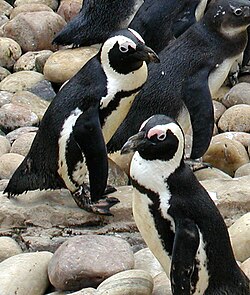African penguin
The African penguin (Spheniscus demersus), also known as the Black-footed or Jackass penguin), is found on the south-western coast of Africa. It lives in colonies on 24 islands between Namibia and Algoa Bay, near Port Elizabeth, South Africa. The largest colony on Dyer Island, near Kleinbaai. Two colonies were established by penguins in the 1980s on the mainland near Cape Town at Boulders Beach near Simon's Town and Stony Point in Betty's Bay. Mainland colonies probably only became possible in recent times due to fewer predators, although the Betty's Bay colony has been attacked by leopards. The only other mainland colony is in Namibia, but it is not known when this was established.
| African penguin | |
|---|---|

| |
| Conservation status | |
| Scientific classification | |
| Kingdom: | |
| Subphylum: | |
| Class: | |
| Order: | |
| Family: | |
| Genus: | |
| Binomial name | |
| Spheniscus demersus (Linnaeus, 1758)
| |
The African penguin may live up to 20 years. It grows up to 65 cm tall and weighs up to 3 kg. They eat fish, crabs and squids. The breeding time is 38 days.
Boulders Beach is a tourist attraction, for the beach, swimming and the penguins. The penguins will allow people to approach them as close as a meter (three ft).
The closest relatives of the African Penguins are the Humboldt and Magellanic penguins found in southern South America and the Galápagos Penguin found in the Pacific Ocean near the equator.
| Wikispecies has information on: Spheniscus demersus. |
African Penguin Media
Penguin colony at Betty's Bay
African penguin diving in Siam Center, Bangkok, Thailand
African penguin skeleton at the Museum of Osteology in Oklahoma City, Oklahoma, US
Two adults with chicks at the Boulders Beach colony in South Africa
Egg from the collection of Museum Wiesbaden, Wiesbaden, Hesse, Germany
Nesting burrows of the African penguin, Boulders Beach (2017)
African penguin at the New England Aquarium, Boston, Massachusetts, United States
(video) African penguin swims in an aquarium in Tokyo, Japan
African penguin at the Dallas World Aquarium, Dallas, Texas, United States
References
- ↑ BirdLife International (2012). "Spheniscus demersus". IUCN Red List of Threatened Species. Version 2012.1. International Union for Conservation of Nature. Retrieved 16 July 2012.








